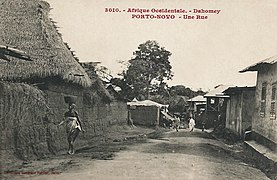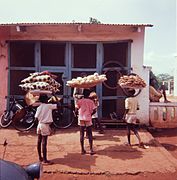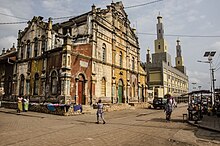Porto Novo
Porto Novo, also known as Hogbonou and Adjacé, is the capital and second largest city of Benin, after Cotonou. The city is a port on the Porto-Novo Bay, part of the Gulf of Guinea. Porto Novo is the main city of the country, both politically and culturally. The city is the center of an agricultural area that produces mainly palm oil, cotton, and kapok. In the 1990s, oil was found on the coast in front of the city, which is why it has become an important export center for this hydrocarbon.
Geography
Topography
Porto-Novo is located in the south of Benin, 13 kilometers from the Atlantic Ocean, from which it is separated by a lagoon, the Lagua de Porto- Novo or Lac Nokoué. Its altitude is about 245 meters and it covers 52 km2.
It is 30 kilometers to the west of Cotonou, the economic capital, and 12 kilometers from the Nigerian border to the east. The bordering municipalities are Akpro-Missérété, Avrankou and Adjarra to the north, Sèmè-Kpodji to the south, Adjarra to the east and Aguégués to the west.
Climate
The city has a particular humid tropical climate called a subequatorial climate, with four seasons, two dry (from November to mid-March, and from mid-July to mid-September) and two wet (from mid-March to mid-September). July, and from mid-September to mid-November). Humidity is high (75%), temperatures vary between 21.9 °C and 32.8 °C, rainfall averages 1200 mm per year. The harmattan blows from December to January a cold and dry wind.
| Month | Ene. | Feb. | Mar. | Open up. | May. | Jun. | Jul. | Ago. | Sep. | Oct. | Nov. | Dec. | Annual |
|---|---|---|---|---|---|---|---|---|---|---|---|---|---|
| Average temperature (°C) | 27 | 28 | 28 | 28 | 27 | 26 | 25 | 25 | 25 | 26 | 27 | 27 | 26 |
| Rains (mm) | 23 | 34 | 86 | 127 | 215 | 370 | 129 | 44 | 89 | 140 | 52 | 16 | 1325 |
| Source: | |||||||||||||
Administrative Geography
The municipality of Porto-Novo is divided into five districts: Houèzoumè, Attakê, Djassin, Houinmè and Ouando. These districts are subdivided into neighborhoods.
History
Porto Novo was probably founded in the second half of the 16th century by the legendary king Te-Agdanlin of Allada. Its name derives from & # 34; new port & # 34; in Portuguese. It was the Portuguese Eucaristo de Campos who called the city "Porto-Novo" for its resemblance to the city of Porto. The town developed a great activity of trade and slave trade to all of America.
The Kingdom of Ardra came under the protection of France in 1863 to defend against the British siege; however, the neighboring kingdom of Abomey did not tolerate this rapprochement towards France and a war began between the two African states. In 1883, with the arrival of the French army in Porto Novo and Cotonou, the region was incorporated into the "colony of Dahomey and its dependencies", to become its capital since 1900.
The kings of Porto-Novo continued to rule the city until the death of the last king, Alohinto Gbeffa, in 1976. From 1908, they were known as Chef supérieur (French for Superior Chief)
Many Afro-Brazilians settled in Porto Novo on their return to Africa after the abolition of slavery in Brazil. This caused Brazilian architecture and gastronomy to form an important part of the culture of Porto Novo.
- Images of the colonial era.
Demographics
The city of Porto-Novo, within its administrative limits, had 223,552 inhabitants at the 2002 census. Its density is 1,985 inhabitants/km2. Those under the age of 19 make up more than half of its population. In 2010, there were 314,500 inhabitants.
Porto Novo, like Benin in general, is characterized by great ethnic diversity. The Gouns represent about 80% of the population, the rest is distributed among the Yoruba, Adjas, Toffinus, Minas, Sèto, Tori, Baribas, Dendis, Yoms, Lokpas, Batammaribas and Peuls. For most of the Gouns of Benin and Nigeria, this city is often called the 'Mother City', that of their modern civilization, even if we cannot forget certain Allada origins.
Some of its inhabitants have a surname of Portuguese origin, inherited from the Portuguese colonization. This population is difficult to estimate, because many inhabitants of the region, throughout history, have settled in other regions and cities of Benin, as well as in other regions of the Gulf of Guinea (including Nigeria). The descendants of this group are not necessarily of mixed African and Portuguese descent, but are mostly descendants of Africans converted to Christianity by the Portuguese, and are mostly Catholic. Porto-Novo is one of the few places in the Gulf of Guinea (although there are exceptions: San Pedro in the Ivory Coast or in the former Portuguese colonies) in the region that have retained their Portuguese names.
Some ethnic groups are more specialized in certain economic activities, the Gouns in transport or agriculture, the Yoruba in commerce.
Places of worship
Among the places of worship, there are mainly Christian churches and temples: Diocese of Porto Novo (Catholic Church), Église Protestante Méthodiste du Bénin (World Methodist Council), Église du christianisme céleste, Union des Églises Baptistes du Bénin (Alliance Baptist World), Living Faith Church Worldwide, Redeemed Christian Church of God, Assemblies of God. There are also Muslim mosques.
Economy and transportation
The Porto-Novo region produces oil palm, cotton and Ceiba pentandra. The city is also known for the Ouando market, one of the largest in the country and in West Africa.
Route of downtown.
Places of interest
Porto-Novo has several remarkable places and buildings:
- The Museum of Ethnography of Porto-Novo, which contains an important collection of Yoruba masks, as well as objects of the history of the city and the country.
- The palace of King Toffa, also known as the Honme Museum and the Royal Palace (Le Musée Honmé et le Royal Palace in French), which today is a museum that shows the life of the African monarchy.
- The big square Jardin Place Jean Bayolwhere is the statue of the first king of Porto-Novo.
- The Museo da Silva of the history of Benin, which shows the return of Afro-Brazilians.
- The Governor's Palace (Palais du Gouverneur in French), seat of the House of legislators.
- The Great Mosque of Porto-Novo, formerly a Brazilian-style church.
- The Institute of High Studies of Benin.
- In Porto-Novo you will find the Stade Municipale and Stade Charles de GaulleThe biggest football stadium in the city.
- The National Library of Benin
Porto-Novo is located near the city of Ouidah, the city of Cotonou and neighboring Nigeria, as well as the Pendjari National Park, a natural habitat for many African species.
Adjogan
Adjogan is the endemic music of Porto-Novo. This style of music is played with an alounloun, a stick with close-set metal rings that jingle with the roll of the stick. The alounloun is said to have been a court instrument of King Te-Agdanlin. This music was played in honor of the king and his ministers, and is played in the city's Catholic churches.
Personalities born in Porto Novo
- Marc Tovalou Quenum (1887-1936), lawyer, writer and pan-Africanist
- Paul Hazoumé (1890-1980), ethnologist, writer and political man
- Agoussi Wabi (1899-1941), comrade of the Liberation
- Albert Idohou (1902-1941), comrade of the Liberation
- Louis Ignacio-Pinto (1903-1983), political man and judge of the Hague International Court of Justice
- Samuel B. J. Oshoffa (1909-1985), founder of the Church of celestial Christianity
- Sourou Migan Apithy (1913-1989), political man
- Solange Faladé (1925-2004), psychoanalyst
- Paulin Soumanou Vieyra (1925-1987), filmmaker
- Albert Tévoédjrè (1929-2019), mediator of the Republic of Benin
- Colette Sénami Agossou Houeto (1939-), poet and minister
- Marcelline Aboh (1940-2017), actress
- Jérôme Carlos (1944-), historian, writer and journalist
- Noureini Tidjani-Serpos (1946-), writer and senior official
- Théodore Holo (1948-), jurist, university and political man
- Adelaïde Fassinou (1955-), woman of letters
- Agnès Agboton (1960-), woman of letters
- Moudjib Djinadou (1965-), international writer and official
- Patrick Lozès (1965-), political man
- Miss Espoir (1980-), actress-compositor-intérprete beninesa
- Anicet Adjamossi (1984-), football player
- Mathieu Edjekpan (1985-), footballer
- Bio Aï Traore (1985-), football player
- Safradine Traore (1986-), footballer
- Sinatou Saka (1991-), Beninese journalist
- Frédéric Joël Aïvo (1973-), constitutionalist, university professor and political man.
- Romuald Hazoumè (1962-), artist.
- Janvier Dénagan (1967-2021), singer, percussionist and German composer of origin.
Further reading
- Sappho Charney (1996). "Porto-Novo (Oueme, Benin)". Noelle Watson, ed. International Dictionary of Historic Places: Middle East and Africa (in English). UK: Routledge. p. 588+. ISBN 1884964036.
- J. Geay, Origine, formation et histoire du royaume de Porto-Novo, in Bulletin du Comité d'études historiques et scientifiques de l'Afrique Occidentale française, 1924, p. 619-634 (reading online)
- Basile Marius Gandonou (2006). Monographie de la ville de Porto-Novo (in French). Afrique Conseil. Gandonou2006. Archived from the original on January 10, 2020. Consultation on 29 March 2022.
- Adolphe Kindélé and Cyrille Aguessy, Contribution à l'étude de l'histoire de l'ancien royaume de Porto-Novo (Téodore Monod), Institut d'Afrique noire, Dakar, 1953, 168 p.
- Paule Brasseur-Marion and Gérard Brasseur, Porto-Novo et sa palmeraie, Institut français d'Afrique noire, Dakar, 1953, 132 p.
- Moussiliou Mamadou, Islam à Porto-Novo: Des origines à 1930, Université Paris 1, 1980 (memoire de maîtrise d'Histoire)
- Christine Mengin and Alain Godonou (dir.). «Porto-Novo: patrimoine et développement» (in French). Éditions de la Sorbonne / École du patrimoine africain, 2013, 137 p. ISBN 978-2-85944-757-1.
- Benoit N'Bessa, Porto-Novo et Cotonou (Bénin): origine et évolution d'un doublet urbain, Université Bordeaux 3, 1997, 456 p. (thèse d'État de Géographie)
- Marie-Josée Pineau-Jamous. « Porto-Novo: royauté, localité et parenté », Cahiers d'études africaines1986, (in French) (104, vol. 26, cahier 4).
- Alain Sinou and Bachir Oloudé. "Porto-Novo, ville d'Afrique noire" (in French). Orstom, Paris; Parenthèses, Marseille, 1989, 175 p. ISBN 2-86364-051-8.
- B. Volkoff and P. Willaime. «Carte pédologique de reconnaissance de la République populaire du Bénin à 1/200.000. Feuille de Porto-Novo,» (in French). ORSTOM, Paris, 1976, 47 p.
Contenido relacionado
Cumas
Akranes
Mojacar
Battle of Raszyn
Doctor Guillermo Mann Base















